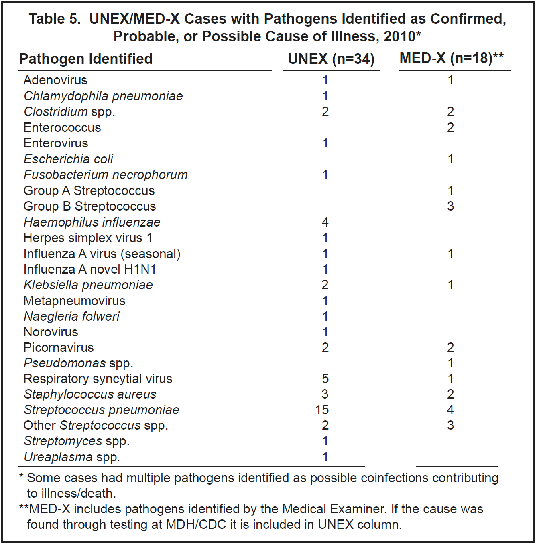Annual Summary of Disease Activity:
Disease Control Newsletter (DCN)
Related Topics
Contact Info
Unexplained Critical Illnesses and Deaths of Possible Infectious Etiology (UNEX) and Medical Examiner Infectious Deaths Surveillance (MED-X), 2010
Surveillance for unexplained critical illnesses and deaths of possible infectious etiology (UNEX) began September 1995. Focus is given to cases < 50 years of age with no significant underlying conditions; however, any case should be reported regardless of the patient’s age or underlying medical conditions to determine if further testing facilitated by MDH may be indicated. In addition to provider reporting, death certificates are reviewed for any deaths <50 years of age with no apparent significant underlying conditions for possible unexplained infectious syndromes.
In 2006, MDH began Medical Examiner Infectious Deaths Surveillance (MED-X) to evaluate all medical examiner (ME) cases for infectious-related deaths. MDH distributes specimen collection kits to MEs to help guide and increase the number and type of specimens collected. All MEs are encouraged to participate, but MDH in particular works with the Minnesota Regional Medical Examiner Office (MRMEO), the Hennepin County Medical Examiner Office, Midwest Medical Examiner’s Office, Ramsey County Medical Examiner Office, and Lakeland Pathology. MEs report explained infectious and unexplained cases to MDH. Unexplained deaths in previously healthy individuals <50 years of age are included regardless of infectious hallmarks; this primarily includes Sudden Unexplained Infant Deaths (SUIDs). In addition, MDH reviews death investigations at MRMEO to capture a population-based rate that includes cases not autopsied. Cases found through active surveillance that have infectious pre-mortem and/or post-mortem findings indicating a possible infectious-related death for which a pathogen was not identified are also considered for UNEX surveillance and are followed-up with for testing if they are <50 years of age and previously healthy.
Testing of pre-mortem and post-mortem specimens is conducted at the PHL and the CDC Infectious Diseases Pathology Branch (IDPB). Cases are excluded from UNEX if they are determined to be explained by providers, are not critically or fatally ill, or have no infectious disease hallmarks.
There were 172 cases that met criteria for UNEX surveillance (144 deaths and 28 critical illnesses) in 2010, compared to 201 cases in 2009. Of the 172 cases, 85 were reported by providers, 71 were found through review of ME records, 7 were found by death certificate review, and 9 were found through other reporting methods. Of the 71 found through MED-X, 14 were <50 years of age; 21 had autopsies performed. Among the 172 cases, 86 cases presented with respiratory symptoms; 21 with neurologic symptoms; 14 with an illness that did not fit a defined syndrome (or had more than one syndrome); 13 with cardiac symptoms; 13 with sudden unexpected death (SUD); 11 with gastrointestinal (GI) illness; 8 with shock/sepsis; 3 with a genitourinary (GU) illness; and 3 with a hepatic syndrome. The age of cases ranged from newborn to 103 years. The median age was 20 years among 86 reported cases, and 76 years among 86 non-reported cases, with an overall median age of 47 years. Fifty-eight percent resided in the metropolitan area and 56% were male.
There were 86 cases that had specimens tested at the PHL and/or the IDPB. Of those, 34 (40%) had one or more pathogens identified as a potential cause of the illness (Table 5). Cases were identified as confirmed (n=21), probable (n=8), or possible (n=4) based on the type of testing performed, the anatomic site of the specimen and the clinical syndrome. The pathogens most frequently identified through UNEX testing as the presumed cause of illness include 15 S. pneumoniae, and 5 respiratory syncytial virus (Table 5). There were also several cases caused by pathogens not expected to occur in Minnesota. One case was in a 7 year-old with fatal meningitis which was determined to be due to Naegleria fowleri, a fresh water ameba not previously confirmed to cause infection this far north in the United States. A 3 month-old who experienced SUID was determined to have influenza and S. pneumoniae co-infection through immunohistochemistry staining on lung tissue.
There were 229 MED-X cases in 2010; 134 of these also met UNEX criteria. Based on MRMEO data, the population-based rate of unexplained but potential infectious disease-related deaths as reported to MEs was 14 per 100,000. The median age of the cases was 49 years, and 56% were male. There were 104 (45%) cases found through death investigation report review, the majority of which were cases that did not have autopsies (n=78 [75%]). MEs reported 92 (40%) cases, death certificate review identified 27 (12%) cases, and 1 case was found through other reporting methods. The most common syndrome was pneumonia/upper respiratory infection (n=106 [46%]). Of the 229 cases, 58 (25%) were confirmed to have had an infectious cause, 125 (55%) had possible infectious causes, and 46 (20%) were due to non-infectious causes (Table 5).

- For up to date information see>> Unexplained Deaths and Critical Illnesses
- Full issue>> Annual Summary of Communicable Diseases Reported to the Minnesota Department of Health, 2010